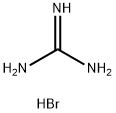guanidine monohydrobromide and its derivatives are known to promote and enable stable 2D perovskite structures. This is done via i) the van der Waals interactions between guanidinium cations, and ii) hydrogen−halogen bonding between guanidinium cations and halide ions of different layers.
The presence of the guanidinium cation results in reduced defect density for the perovskite film and a longer carrier lifetime, due to a hydrogen-bonding effect produced by hydrogen from the guanidinium salt.
Guanidinium bromide (GDBr) and its derivatives are known to promote and?enable stable 2D perovskite structures. This is done via? i) the van der Waals interactions between guanidinium cations, and ii) hydrogen?halogen bonding between guanidinium cations and halide ions of different layers.
Organohalide based perovskites have emerged as an important class of material for solar cell applications. Our perovskites precursors are useful for synthesizing mixed cation or anion perovskites needed for the optimization of the band gap, carrier diffusion length and power conversion efficiency of perovskites based solar cells.
Guanidine has a good bacterial and fungicidal efficacy when used in low concentration and can also be used as disinfectant.

